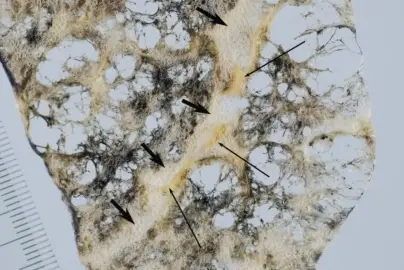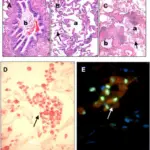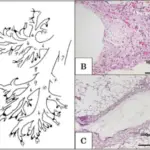Emphysema is a condition of the lung characterized by airspaces distal to the terminal bronchiole becoming destroyed, and there is an irreversible enlargement of the airspaces.
Types of emphysema included:
- Airspace Enlargement with Fibrosis (Irregular Emphysema)
- Bullous Emphysema
- Compensatory Hyperinflation
- Centriacinar (Centrilobar)
- Distal Acinar (Paraseptal)
- Interstial Emphysema
- Obstructive Overinflation
- Panacinar (Panlobar)
- Alpha-1-Antitrypsin Deficiency
What is the Pathology of Emphysema?
The pathology of emphysema is:
-Etiology: The cause of emphysema is Tobacco smoking others include inhalation exposure to chemical vapors, mineral specks of dust, organic dust metal fumes, and exhaust fumes.
-Genes involved: Cytotoxic T-lymphocyte antigen (CTLA) 4.
-Pathogenesis: The sequence of events that lead to emphysema thought to result from the elastin and other alveolar wall components breakdown by enzymes, proteases, that digest protein. Infiltration by foreign antigen to lung epithelial cell barrier, inflammatory immune cells carry the antigens to BALT layer where Proteolytic reaction takes place damaging lungs epithelial.
-Histology: The histology associated with emphysema shows dilation of air spaces and injuries of septal walls of part of acinus intricate.
How does Emphysema Present?
Patients with emphysema typically have gender differences in the prevalence of smoking with females more likely to develop than males, present at age range of > 50 years. The symptoms, features, and clinical findings associated with emphysema include productive cough, dyspnea, wheezing, and acute chest illness.
How is Emphysema Diagnosed?
Emphysema is diagnosed through Spirometry assessment, Arterial blood gas analysis, sputum evaluation, and hematocrit. Imaging Studies, chest radiograph reveals hyper infiltration and HRCT scanning of the chest.
How is Emphysema Treated?
Emphysema is treated through, smoking cessation, medical care for symptoms- bronchodilators, phosphodiesterase inhibitors, anti-inflammatory therapy antibiotics, and oxygen therapy.
What is the Prognosis of Emphysema?
The prognosis of emphysema is fair.



